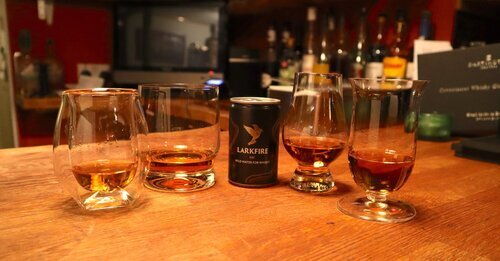Whisky glass review. Four glasses put to the test...
Does the glass make a difference?
Four of the Larkfire team came together bringing a favourite glass and a few drams.
First up was the Glencairn. Loved by the industry, adored by the whisky community and certainly a favourite on Instagram. Launched in 2001 it quickly became the standard by which all are set. If you have been to a whisky tasting event recently you probably used a Glencairn glass.
The design has everything you need for whisky nosing and tasting. A piece of white paper, a Glencairn glass and a rough idea of taste profiles and the whiff of expertise is upon you. A swollen bowl to swirl, a tight neck to trap aromas. The opening is even small enough for a whisky coin. They don’t break the bank so a collection is easily amassed. Our tasting team of four undoubtedly love the Glencairn and have been brought up on the glass at many tasting evenings. However, there was a rebel amongst us.
The classic Glencairn
Riedel Vinum whisky glass
“It’s quite delicate, more of a nosing glass than a true tasting glass” said this turncoat. We looked at him strangely but he held his ground.
“A turned lip allows whisky to touch the tip of the tongue. Any bowl shape throws too much whisky to the back of the mouth.”
And with a certain flair he produced the Riedel glass.
The Riedel glass was designed in 1992 and is again a delicate glass that is held lightly. It’s dishwasher safe but why on earth would you put a whisky glass in the dishwasher? Heathens.
The shape still allows a good view of colour. Those bringing a piece of white paper to a whisky tasting can rest easy. It’s a serious whisky glass and it has some fans in the community. The shape does allow nosing but without the concentration of the Glencairn. Is there a such a thing as “too much nose” from a glass? Some in the group felt so and the Riedel won a few nods of appreciation.
“But what about weight? I like a glass with a bit of heft, something you can feel in your hand”
Another dissenter had appeared and we were drawn to a Dartington tumbler. There are no “technical” arguments around a tumbler but why should there be? Whisky should be enjoyed slowly so the feel of a glass in your hand should be important. Notably, we all slowed down with this glass in our hand.
(Readers, a delicious Balvenie 12 year old with Larkfire may have helped).
So does this mean there is a glass for any occasion? Can you please everyone all of the time? Well, this is what Norlan have tried to do. The feel of a tumbler, trapping aromas (without too much raw alcohol) and the turned lip for tasting.
The Norlan glass burst onto the scene in 2015 with an incredibly successful Kickstarter campaign. There were many fans in the room but it was the beauty of the glass rather than the technical arguments that won hearts and mouths. The Norlan does deliver on the promise of reducing the ethanol “bloom” you can get with a nosing glass. It’s a little light but it still has some “heft” (Our tumbler fan was happy). Did we say it was beautiful though?
We spent some time drinking a Bruichladdich (splash of Larkfire naturally) but mainly we drifted off looking at the glass. It’s not a cheap glass but if you spend over £50 regularly on a bottle why would you skimp on glassware?
Four glasses, each with their place in a particular whisky moment. A Glencairn or Riedel for understanding a whisky, a Norlan for a more relaxed social occasion and if you are partial to a Mizuwari serve (as we are) then a tumbler is undoubtedly best.
Did we say it was beautiful?





